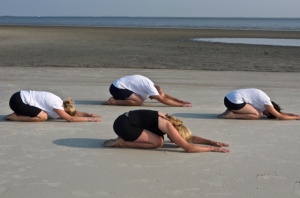
Inside Yoga 275 (15/7/2019)
Spoiler alert: the answer to the question, is yoga meant to be relaxing?, is both yes and no, because as we find in life most questions cannot be answered with a simple yes or no, and in particular, this question is asking what is the purpose not what do we think we are going to get from yoga.
Ask people who have not practised yoga about yoga and a lot will say it is relaxing – which it is – but go to a yoga class (I cannot guarantee all yoga classes are as I describe but a traditionally based ones are), most people discover that they are not being taught to relax whilst in the class. They are being taught to focus and concentrate, whilst doing some exercises along the way, and by the end what we often feel is a deep sense of relaxation, or to put it another way, we feel liberated of all those thoughts and feelings which had been dragging us back or down prior to the class.
The Yoga Sutras by Patanjali has eight limbs or parts; the first four are concerned with our approach (ethical guidelines: yamas and niyamas) and the physical exercises (asanas) and breathing (pranayamas). But importantly, for my point being made above; the next four parts are focused on how we practice: Pratyahara (withdrawal or control of the senses; a quietening of everything); Dharana (concentration or control of our mind, focussing); Dhyana (meditation or control of our consciousness, paying attention to an object, such as our breathing) and Samadhi (absorption in a sense of union, or a state of meditation in which only the object of meditation is apparent, such as our breath).
There is no reference above to relaxation, or that yoga is a relaxation practice. When we go to a yoga class, or practice at home, we are going through a series of exercises during which we do our best to concentrate on what we are doing, to the exclusion of all distractions, whether they be thoughts, sounds, or feelings. And importantly when distracted we do our best to refocus on the yoga practice and being present (mindful).
The practice of yoga is designed to strip away what we don’t need and keep things simple, with a series of exercises to keep us focused, and through this process we do find that during the practice and by the end we often feel more relaxed than we were at the beginning. But, we worked hard to achieve the goal of feeling relaxed. We did not arrive at class and put our feet up for a spot of relaxation (as if we were by the pool!).
There are yoga exercises which are very gentle physically, so outwardly they do look very relaxing so can give the impression that yoga is all about relaxation, but the practitioner while appearing perfectly still is busy inside keeping the thoughts at bay and the breath steady, which takes a lot of effort.
Anyone who meditates will remember how in the beginning meditating can be challenging and hard work, because we spend much our time doing our best to stop our thoughts from distracting us. Thoughts and sounds keep attracting our attention and we might feel we spend most of our meditation trying to quieten our thoughts, but this is what meditation involves. No meditator expects to sit for a whole session with a completely still mind. Even the experienced meditator expects distractions to happen and the yoga training teaches us how to calmly return to the point of the practice. In other word, we learn to respond appropriately to every moment.
The skill of a meditator is to sharpen our awareness and clarity so that we stop these thoughts quicker and earlier before we become lost in thought, for example, we can so easily find that we have planned the rest of our life before realising where our thoughts have taken us!! We train our mind to see the thought as it starts, like a shoot coming up out of the soil, stopping it before it grows. (Please note: there is plenty of time outside our yoga and meditation practice to think and daydream!)
What we do see is that by the end of the session, and even during it, we feel increasingly more relaxed. It is not the successful asanas practice or meditation which produces the results we might seek, for example, feeling relaxed, but the process which produces the results and benefits, for example, feeling light in our being, a quieter mind, feeling more relaxed and calmer, and so on. The benefits are numerous and this is why we do it, but is not correct to think that yoga is meant to be relaxing or in itself a relaxation practice. But it is at the same time, relaxing, such is the paradoxical nature of yoga and life itself.
You can read more about Patanjali’s sutras in previous articles on my blog page, see links below:
Practice, patience and perseverance: https://www.yogabristol.co.uk/2019/05/06/practice-patience-perseverance/
Paying attention and why it’s important:
https://www.yogabristol.co.uk/2019/02/04/paying-attention-important/
Below are old articles about the yoga sutras:
https://www.yogabristol.co.uk/2011/03/15/inside-yoga-29/
https://www.yogabristol.co.uk/2011/02/28/inside-yoga-9/
https://www.yogabristol.co.uk/2011/02/28/inside-yoga-8/
https://www.yogabristol.co.uk/2011/02/28/inside-yoga-7/
https://www.yogabristol.co.uk/2011/02/28/inside-yoga-6/
https://www.yogabristol.co.uk/2011/02/07/inside-yoga-4/
https://www.yogabristol.co.uk/2011/02/07/inside-yoga-3/
Your Comment: Let me know what you think. See reply panel below or email me, gary@yogabristol.co.uk
